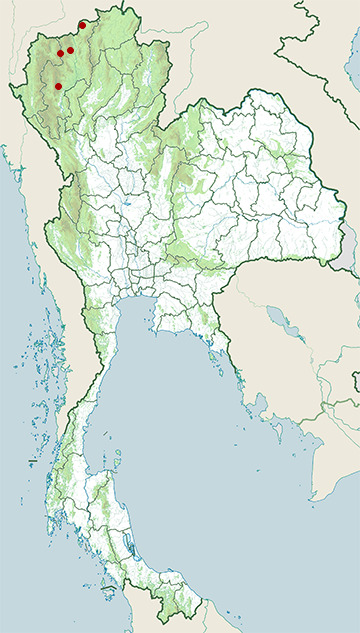Species of Thailand
Pale-footed bush warbler
Urosphena pallidipes
William Thomas Blanford, 1872
In Thai: นกกระจ้อยสีไพล
The pale-footed bush warbler (Urosphena pallidipes) is a species of oriental warbler in the family Cettiidae, found in southern Asia. The pale-footed bush warbler is found in the Himalayan region west from Deharadum through the foothills of Nepal to the Northeast India. This species is further found in Myanmar, Laos, northern Vietnam and southern China. A single sight was recorded from Kandy, Sri Lanka in March 1993.
Subspecies
There are three subspecies of pale-footed bush warbler
- U. p. pallidipes
- U. p. osmastoni
- U. p. laurentei
Distribution and Habitat
The pale-footed bush warbler usually associates with Themeda grasslands. The habitat and altitudinal limit for pale-footed bush warbler slightly vary from place to place. For example, in Thailand, its habitat is known as grassland and scrub from foothills up to 1800 m. In China, its habitat is known as woodland up to 1525 m.
Nepal
The pale-footed bush warbler is a resident bird for Nepal. It is mostly found in Chitwan. This species as well as other species of the birds in Nepal are threatened due to habitat loss and population decline in Nepal.
India
Urosphena pallidipes was first described in The Fauna of British India, Including Ceylon and Burma Vol.2, by William Thomas Blanford and Eugene W. Oates in the year 1874.
In peninsular India the pale-footed bush warbler U. p. pallidipes has been reported as breeding in the Eastern Ghats by Salim Ali and Sidney Dillon Ripley. They collected a specimen from Sunkarametta, Araku Valley, Vishakapatnam district (altitude of 1000m) in the month of April A male adult of the subspecies U. p. osmastoni was first described from Andaman Islands (altitude 730m) by Ernst Hartert. Nest-building in U. p. osmastoni was described by Bertram Beresford Osmaston in the year 1907 Subspecies U. p. pallidipes has also been reported from Simlipal Tiger Reserve, Simlipal National Park Odisha (altitude 600-1500m) in December 2012 from a grassland near a Sal forest
Ecology and behavior
The pale-footed bush warbler is extremely shy and is a great skulker, meaning it is very difficult to see even during the breeding season. This species breeds from May to July. The bird is usually found either by itself or in pairs in low bushes and grass clumps. It is also known as lowland species. It likes to stay close to ground; thus, it flies less than a meter high above ground. It moves through grass reeds keeping it low, staying mostly out of sight. It feeds on the lower half of grass reeds.
Vocalization
The pale-footed bush warbler has a loud song. Because the pale-footed bush warbler stays in the lower part of its habitat, it is more easily heard than seen. This species remains mostly silent during winter but its call and song can be easily heard during spring. Its explosive song is the best way to signal its species.
This article uses material from Wikipedia released under the Creative Commons Attribution-Share-Alike Licence 3.0. Eventual photos shown in this page may or may not be from Wikipedia, please see the license details for photos in photo by-lines.
Category / Seasonal Status
BCST Category: Recorded in an apparently wild state within the last 50 years
BCST Seasonal status: Resident or presumed resident
Scientific classification
- Kingdom
- Animalia
- Phylum
- Chordata
- Class
- Aves
- Order
- Passeriformes
- Family
- Cettiidae
- Genus
- Urosphena
- Species
- Urosphena pallidipes
Common names
- Thai: นกกระจ้อยสีไพล
Conservation status

Least Concern (IUCN3.1)
Photos

Range Map

- Chiang Dao Wildlife Sanctuary
- Doi Inthanon National Park
- Doi Pha Hom Pok National Park
- Huai Nam Dang National Park